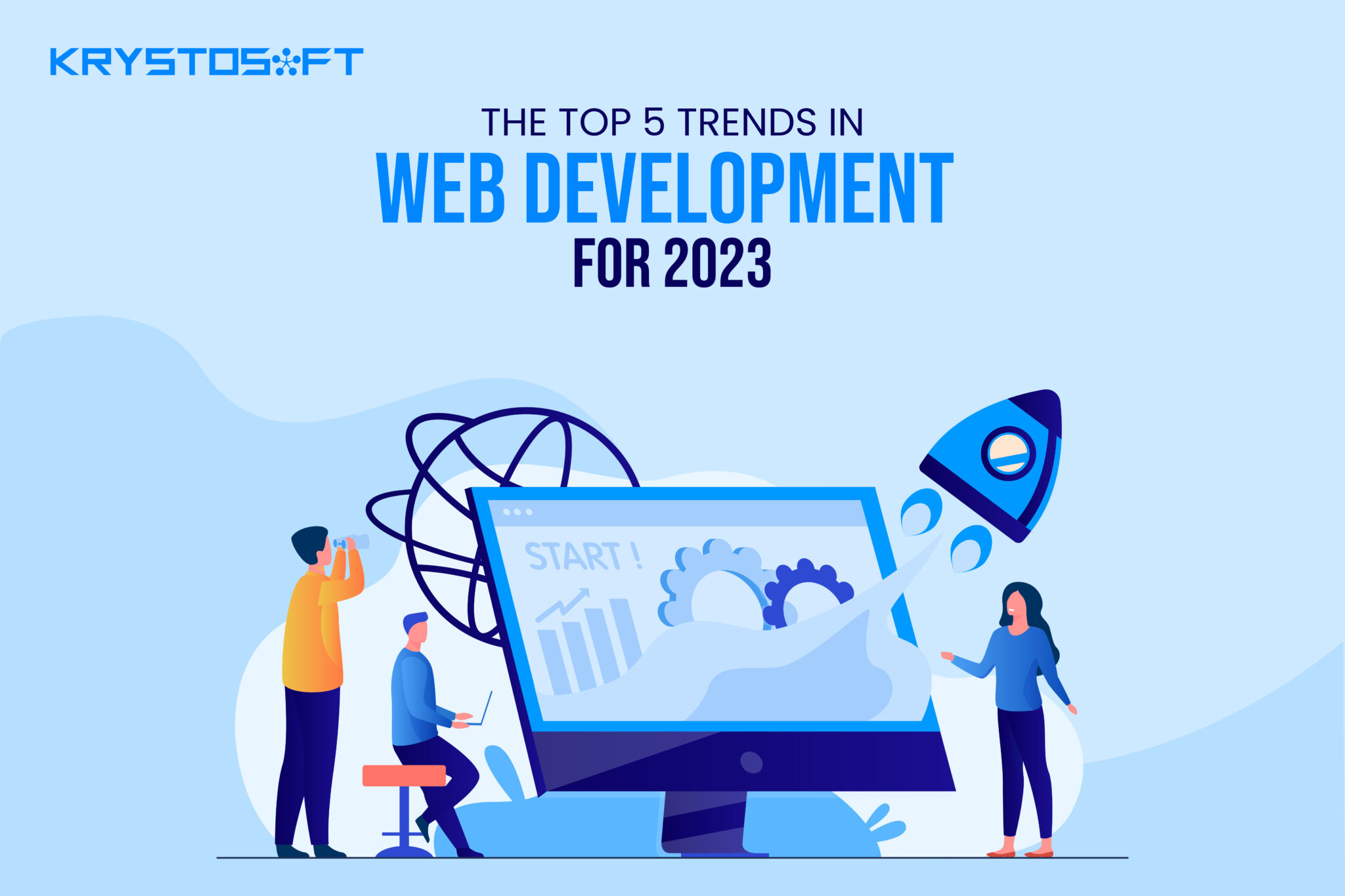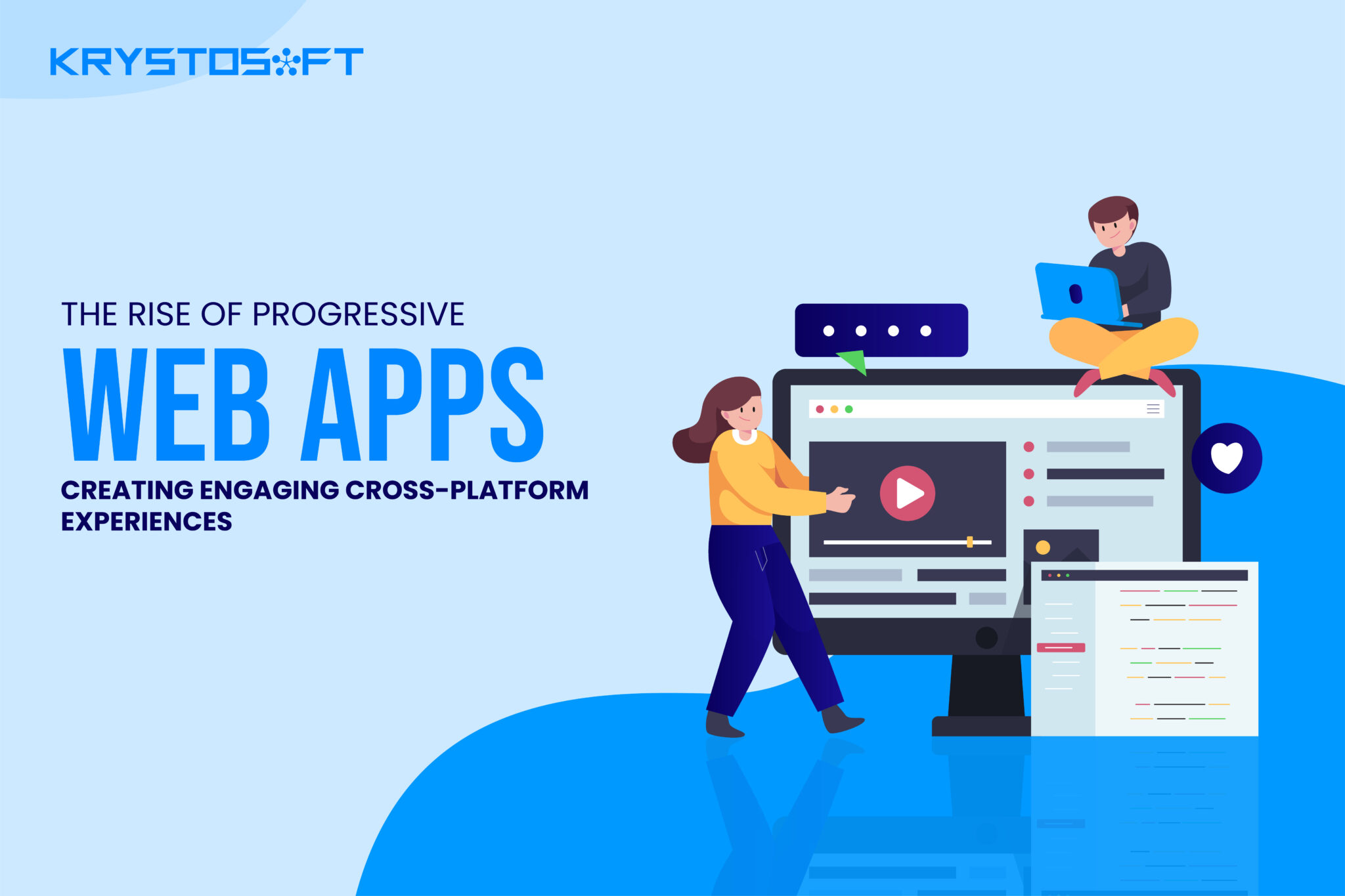Do you know that as of 2023, there are a total of 5.18 billion internet users worldwide? Whereas, the world’s population stands at 8.04 billion. Now, do the maths, and you’ll realize that the ever-increasing worldwide web encompasses 64.6% of the world’s population. And, considering the pace of technological advancements, we can only expect this percentage to grow.

With 2023 nearing the end, we are likely to see some new trends in web development. Thus in today’s blog, we’ll explore the top five web development trends for 2023
1. The Emerging Role of AI
AI has already started to play a major role in our lives. With the introduction of AI bots like Bard and Chat GPT, writing takes less time. The same goes for AI’s role in website design.
Because of the emergence of AI, we can see a decrease in the time it takes to write website content. As a result, we can see that AI is likely to lessen the time it takes to design a complete website.
Now, all you need to do is to ask for a concept and tweak it a bit to meet your client’s needs.
But, that’s not where the story ends.
As of the latest web trends, clients also demand that their website should have an AI chatbot to respond to customer queries. AI chatbots improve customer satisfaction by offering prompt support. As a result, they’ve become popular among website owners.
According to Comm 100, a notable provider of customer service and communication products, the success rate of AI chatbots is 87.58%, which is 1.78% more than that of human customer support agents. Thus, we can see that the inclusion of AI chatbots is positive, and hence an emerging trend in web development.
In conclusion, the emergence of AI is gradually changing the web development landscape, by making content writing and changing client demands.
1. Responsive Web Design
You open a website on your PC, and it starts displaying like “fine wine.” Next, you open the same website on your phone, and it looks like a scattered jigsaw puzzle. Now, imagine if the end-user gets in a similar situation. It’ll leave him bonkers. Right?
Here’s where responsive web design comes into play. With responsive website design, we aim to ensure that the user receives the same website result, regardless of which device they open the website on.
Moreover, when your website is responsive, it’s also a major factor in decreasing its bounce rate. After all, think about it. Why would a user stick to a website and surf through it, if it looks like a labyrinth of out-of-context text and images? Rather, they move to another website. So, having a website that’s mobile-friendly, and shapes itself to any screen size is important.
Now, let’s look at how the stats add weight to the notion. According to an article published on Linkedin from Volmatica, an information and technology services firm, 8 out of 10 visitors will give up reading information on your website if the design isn’t responsive.
Moreover, 67% of users prefer to purchase products from responsive websites. So, as a developer, focusing on a responsive web design yields better results for your clients.
2. Voice Search Optimization
In the 21st century, people are relying more on voice search for search results. Stats show that around 20 % of global mobile searches are done through voice recognition. Moreover, 72 % of the people use voice searches daily. Therefore, optimizing your website for voice search is important.
So, now, it’s time for the “million-dollar question.” What can you do to optimize your website for voice search results? First, go for conversational queries. Target long-tail keywords that pose a question.
For example, use phrases like, which is the best pizza restaurant nearby. Or, where can I find the cheapest gaming consoles?
Pro Tip:
While choosing which keywords to target, think about what questions a customer would ask. By putting yourself in their shoes, you’ll be able to cherry-pick the best keywords to optimize for.
Next, strengthen your local presence. Statistics from a survey conducted by Brightlocal in 2018 showed that 58% of consumers in the past 12 months used voice search for local businesses. So, it’s important to optimize for local searches.
Hence, working on voice searches improves your website’s interface and helps it rank higher on Google.
3. Single-Page Application
Users don’t want the hassle of going from one page to another on an application. This is where single-page applications come into play. Now, rather than opening separate pages for new data, the server rewrites data on the existing page to change the content according to user needs.
Still, if the term sounds new to you, don’t worry, the examples will show how commonly you encounter single-page applications daily. Examples include Netflix, YouTube, and Facebook. Startling isn’t it?
Now, why is having a single-page web application important? Once again, let’s look at the stats. An article published by SoftWeb Solutions shows that a one-second delay in a web page loading resulted in a 7% decrease in conversions, an 11% decrease in page views, and a 16% decrease in customer satisfaction. So, like they say, every second counts.
On the contrary, a single-page application denies this by continuously rewriting data on the same page. So, you have happier users, leading to higher conversion ratios.
4. Accelerated Mobile Pages
Everyone likes fast-loading pages. Thus, AMPs (accelerated mobile pages) are a top priority. AMPs streamline HTML code, removing the inefficiencies that result in slow-loading pages.
For example, AMPs remove some HTML tags with custom tags to improve performance. Now, think of how important this is for mobile optimization. Consequently, AMPs also improve the responsiveness of your site, improving traffic to your website and inevitably, your conversion rate.
To further support this, let’s look at what the numbers say about this new trend in web development. A 2019 research paper from the 25th Annual International Conference on Mobile Computing and Networking. Los Cabos, AMP pages load 2.5 times faster than non-AMP pages. As a result, it provides a more fluid user experience. Thus, using AMPs helps create both user and search-engine-friendly websites.
5. Progressive Web Apps
Another trend that we see in web development is the emergence of progressive web apps (PWAs). So, what is a PWA? A PWA is an app that functions similarly on both mobile and web. So, you get an app-like experience on the website.
Some notable examples of PWAs are Gmail. Whether you open Gmail on your mobile phone or desktop, the interface remains the same, helping you seamlessly navigate through your emails without any glitches or functioning issues.
As a result, whether you’re sitting at a restaurant, or in an office, you can access it from anywhere without worry.
The Ending Note
Web development is on the boom, particularly after the emerging and soon-to-boom e-commerce industry. The current trend in website development sees a turn toward simplifying the process and simultaneously providing an optimum user experience. Thus, It’s important that web developers stay aware of upcoming trends, and upgrade their skill set to meet the continuously changing consumer needs.





